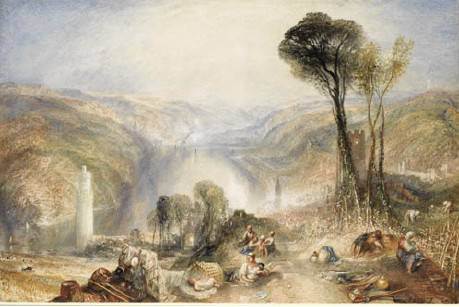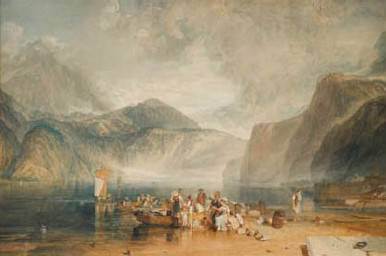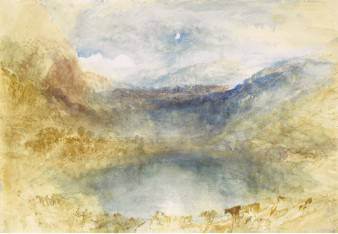
Joseph Mallord William Turner: Oberwesel (1840)

Joseph Mallord William Turner: Lake Lucerne(1807-10)

Joseph Mallord William Turner: Lungernsee (c.1848)
Turner watercolours at Sotheby’s, July 2007 Sothebys announces that on Thursday, July 5, 2007, it will offer for sale one of the finest collections of watercolours by Joseph Mallord William Turner to have come to the market in living memory]]>
THURSDAY, FEBRUARY 15, 2007, source: Sotheby’s
Sotheby’s announces today that on Thursday, July 5, 2007, it will offer for sale one of the finest collections of watercolours by Joseph Mallord William Turner R.A., (1775-1851) to have come to the market in living memory. Britain’s greatest watercolourist, Turner now enjoys an international reputation – something that has driven prices to ever-higher levels in recent years. (Last year, an exceptional Turner oil painting of Venice sold for $35.8 million in New York, while in London, The Blue Rigi – one of a series of three important watercolours depicting Lake Lucerne – made £5.8 million, the record for any watercolour at auction.) Carrying a combined estimate of £10–15 million (US$ 19.7- 29.55 million/€15,000,000-22,500,000), the 14 watercolours to be sold in July embrace almost every aspect of Turner’s achievements. Their sale is set to be a landmark event; their extensive exhibition at locations in Asia, America and throughout Europe, is expected to reconfirm the enormous international appeal and relevance of Turner’s work (he has influenced contemporary artists such as Peter Lanyon and Mark Rothko, and his legacy lives on still in the pre-eminent contemporary British art award – the Turner Prize – that takes his name); and at the same time these exhibitions, open to everyone, will afford the public an opportunity to experience a group of works that together summarise the genius of Turner.
In subject and style, the works in the Ullens collection cover everything from lively, naturalistic renditions of British coastal scenes to almost impressionistic views in Switzerland, Germany, France and Italy. Spanning the first half of the 19th century, the works allow for a clear chronological appreciation of Turner’s development but, whether early or late, naturalistic or impressionistic, all the watercolours bear the vivid hallmarks of Turner’s unique – and very physical – relationship with the medium: his energetic handling of colour, often applied in rapid, scratch-like strokes, or smeared into place with his fingertips, or scratched away with the tip of a brush to reveal the paper beneath. In addition, almost every one of the watercolours benefits from a distinguished provenance, having previously belonged to notable contemporaries of the artist such as the indefatigable art critic John Ruskin, or Turner’s great patron and friend, the Yorkshire landowner Walter Fawkes.
Painted in 1840, Oberwesel (est: £2,000,000-3,000,000) is one of six late watercolours in the collection, which together mark a pivotal moment of development in Turner’s career – a moment when, according to Ruskin, Turner’s works attained “a vigour and concentration which rendered [them]… almost incomparable with those which preceded them. (A watercolour of this period and style which came to sale at Sotheby’s London in 2001, Heidelberg with a rainbow of 1840-45, realised £2,038,500 – then a record for any watercolour by a wide margin.)
Painted at around the same time, c.1840, Venice: Looking towards the Dogana and San Giorgio Maggiore, with a storm approaching, is a free and expressive work. Here, in characteristically unorthodox manner, Turner chose not to focus solely on the architecture of Venice, but instead uses its architecture as an anchor for the central subject of the drawing – bobbing gondolas and the gathering clouds that presage a storm. One of a number of watercolours on the theme of storms, the drawing was once part of Turner’s “Storm” sketchbook – the works from which rank among Turner’s most profound responses to Venice. Evoking both the beauty and the vulnerability of this magnificent city, Venice (est: £800,000-1,200,000) belongs to a group of late Turner watercolours which are now recognised to be among the most remarkable achievements in British art.
Captivated by the drama of the scenery, Turner returned to Switzerland repeatedly. The Ullens collection includes no fewer than six Swiss views that chart his reactions to the place over some 40 years. Among the earliest of the Swiss watercolours, The Lake Lucerne, from the landing place at Fluellen (illustrated left) derives from a sketch made on Turner’s first visit there in 1802. Estimated at £2,000,000-3,000,000, it captures Turner’s fascination with the sublime beauty of the region, combining an extraordinary Alpine view (with dawn breaking over the mountains, as the sun slowly penetrates the lake), with an intimate early morning scene of women and children disembarking from boats, unloading blankets, barrels and clothing. Probably drawn between 1807 and 1810, and exhibited at the Royal Academy in 1815, the watercolour represents the climax of a sequence of nine large-scale evocations of the Alps, all of which were based on material gathered in the 1802 visit. Turner used an extremely large sheet of paper (66 by 100cm/26 by 39 in.), the size of which was purposely chosen to be as close a match as possible to that of a standard oil canvas – all part of Turner’s attack on the preconceived ideas of the limitations of his favoured medium. Turner’s championing of the watercolour added fuel to the jingoistic feeling at the time that Britain had, at last, established its own art form – something which was set in stone when Walter Fawkes exhibited his collection of watercolours by Turner and other artists at his London home at Grosvenor Place in 1819. The show was a triumph: extensively and favourably reviewed in the burgeoning art press, it attracted foreign, as well as British, visitors.
Also based on a sketch made in 1802 is Turner’s dramatic rendition of Lake of Thun (est: £500,000-800,000; illustrated left). Drawn c.1804-6, this free and vigorous work captures the violence of a lightening storm over lake Thun, demonstrating Turner’s early fascination with the fierce and awesome power of the natural world – something that for him and his contemporaries most probably found a human echo in the force of Napoleon’s troops, which were then beating a path across Europe and which, in 1799, just two years before Turner’s visit, had been engaged in fierce battle with the Swiss at this very same spot.
The collection also includes four later Swiss views, painted in the 1840s. Turner’s late Swiss watercolours are among his most brilliant and evocative works – the fruit of five decades of experimentation with the watercolour medium. Each of the late Swiss works in the Ullens collection is a masterpiece of poetic invention: Lausanne from the West (est: £600,000-800,000) of 1841 demonstrates a richness of imagination that is astonishing even among Turner’s late Swiss studies; A Swiss Mountain Scene, probably in the Domleschg Valley in Grisons, c.1841. (est: £300,000-500,000) was described by John Ruskin (who once owned the drawing) as “an exquisite sketch. One of the most beautiful existing of the late time”; and Lake Lucerne (est: £600,000-800,000), painted in what Ruskin described as Turner’s “hazy” style, ranks among the most delicate and subtle of all Turner’s views of the Swiss lakes.
A further Swiss view from this period is the magnificent Lungernsee of circa 1848. Estimated at £2,000,000-3,000,000, this magnificent loosely drawn work shows Lake Lucerne, with the snow-capped mountains of the Wetterhorn visible in the distance. The level of the lake is pronouncedly low, following a dramatic saga between 1788 and 1836 –entailing explosions and landslides – in which the level of the lake was artificially reduced.
While Turner drew enormous inspiration from the scenery of Switzerland, he was certainly not immune to the beauty of his home land. Executed in 1818, Scarborough (£300,000-500,000) is one of a series of works in which Turner refined his topographical style – as the Impressionists were to do after him – by varying the time of day and the weather conditions. Like so many other works in the collection, this dramatic rendition of the Yorkshire coast once belonged to the admiring Ruskin.
Similarly, in Fishing Boats off Hastings (est: £200,000-300,000), Turner evokes the power of the sea and the grandeur of rock formations, with the ruins of William the Conqueror’s castle, built to stamp Norman control on Britain and no doubt a discreet allusion to Napoleon’s ambitions, perched high above. In Fishing Boats off Hastings, Turner’s passionate feeling for nature is conveyed through his technique of vigorous scratching out of colour in order to heighten the tonal contrast by allowing the colour of the paper to show through. The watercolour combines a passionate feeling for nature with a sharp observation of human activity.
Further works in the collection include two views of Bonneville, in Savoy: A View from the Castle of St. Michel, Bonneville, Savoy, from the Banks of the Arve River, c.1807, (est: £200,000-300,000) and Bonneville, of 1817 (est: £200,000-300,000). The collection is completed by The Junction of the Lahn with the Rhine (illustrated left), 1817, a work that fully demonstrates Turner’s vigorous handling of paint, much of which is applied in rapid scratch-like strokes and smudged into place with his fingertips (est: £100,000-150,000); and an evocative Field of Waterloo, from the Picton Tree, c.1833.- one of a series of landscapes and historical scenes which Turner prepared to serve as the basis for engravings to illustrate a book on the life of Napoleon.
Follow us on:
